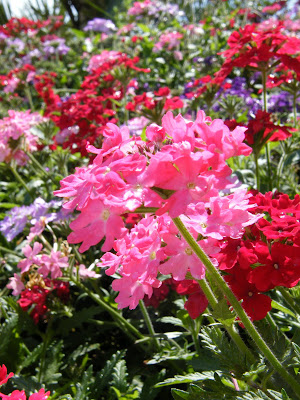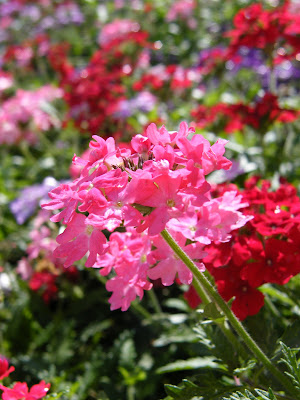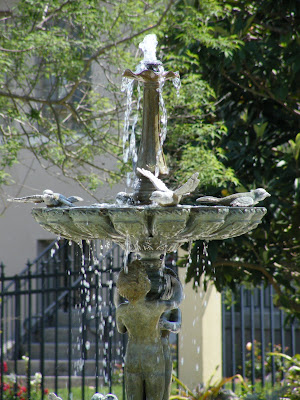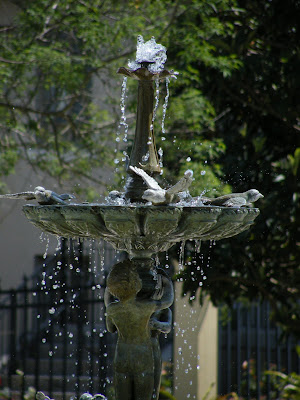Hi everybody! It's Christy - I'm back with another post about using your cameras to the fullest! First of all, thanks so much for your kind comments. I'm kind of a comment-a-holic. They really make my day. Seriously.
This time around, we are going to talk about mid-level cameras. Some people call them hybrid cameras, because they combine the ease of point-and-shoot cameras with a selection of the features from professional-type DSLR cameras.
I went to our lovely, local public garden to shoot pictures for this post and realized that really, there is too much information and I took too many pictures (!), so I'm going to split it up into two posts - aperture and shutter speed today and some tweaks and fun buttons tomorrow. K?
Alright.
Aperture and shutter speed both control the amount of light that comes into your camera. It used to be about how much light the film was exposed to, but now it controls the light that reaches your digital camera's sensor.
Let's start with
aperture. I want to keep this pretty simple here, so if you want more information, follow that link, buy a book, or take a class. It's way more fun and authors and teachers know more than I do. I promise.
Basically, "aperture" refers to how wide your camera's, uh, eyelid opens when you click the shutter. It's measured in "
f stops" and on mid-range cameras, you are likely to see aperture ranges from F2.8 to F8 or F11. But here's the tricky part:
the higher the number is, the smaller the opening is. I know, right? It doesn't seem to make sense. The main thing you need to know about aperture is a low f-stop (low number) lets in
more light. So, if I were taking pictures in the sun, I'd want a high number and if I were taking pictures in the shade, I'd want a lower number.
Got that?
With a mid-level camera, you now have some (read: limited) control over your camera's aperture. You can adjust this number if you have your camera set to "aperture priority." In aperture priority, you select the aperture and the camera automatically adjusts everything else (very polite, yes?). My camera has a dial on top, and the setting is "A." Some cameras have "Av." Use your manual to figure out how to change the f stop. Play around with it and see what happens. My little Fuji S8000fd has a decent range of aperture settings - from F2.8 to F8.
The other thing that your aperture controls is your
depth of field. You know how some pictures have the subject in focus and everything else is nice and blurry? I like those kind of pictures a lot. You can use your aperture controls to achieve that effect. Here is the same flower, shot at two different f stops:
This one is f8

and this one is f3.5

The difference is pretty dramatic, don't you think? It would be more dramatic if I could gone all the way down to 2.8, but that let in so much light that the flower had crazy, eye-piercing, glowing white highlights. Nobody wants to see that.
Shutter speed, well, it's pretty self-explanatory, right? Not so fast. It doesn't actually refer to how fast your shutter is, but to how long your shutter stays open. Again, adjusting your shutter speed controls how much light your sensor is exposed to, but it also controls how you capture motion. If your shutter speed is too slow and your subject is moving - even slightly - your pictures will be blurry. Think bamboo on a windy day. That could really be blurry.
Sometimes blur is good, though. It conveys motion. Spokes on a bike wheel should be blurry, right? Otherwise, the bike might just be parked with some helmeted dude sitting on it, as far as you can tell from the picture.
So, shutter speed can be kind of a creative control. You decide what you want to convey to your viewers. Shutter speeds on my mid-level camera ranges from 4 seconds to 1/2000th of a second. Obviously, 1/2000th of a second will freeze motion right in its tracks. But if I'm in the shade or inside my house, it's definitely not going to let in enough light to see the subject of my photo. Four seconds will make any motion at all blurry, but will let in lots of light. Lots of it.
You can shoot in "shutter priority" on your mid-level camera, just like you can shoot in "aperture priority." You select the shutter speed and the camera figures out the rest. On my camera, I set the dial to "S," but on others it's labeled "Tv." Go figure.
I spotted a fountain that could perfectly demonstrate the use of shutter speed - the water is constantly in motion.
Here's the fountain at 1/200th of a second:

I mean, it's sort of a pretty picture. Obviously, the water is moving. I can tell what's going on here. But it's a little washed out and I'm not sure I like overall look of this photo.
Here is the same fountain shot at 1/1000th of a second:

The drops are nearly frozen in place. It's still obvious that the water is in motion because, well, water doesn't just hang out in mid-air like that. But the colors of this one are richer, and even though I'd prefer to lighten it up a bit and fix a few things with some editing software, I like this photo much better.
One more note about shutter speed: you probably will not have fractions listed as options to select. the numbers move from 2000 (which is really 1/200-th) backwards to 0.3 and such, and then up to 1, 2, 3, etc. I hope that makes sense. It likely will if you pull out your camera and start messing around with your shutter speed.
As you begin to shoot in aperture priority and shutter speed priority, you will find that there are some things your camera just won't do. If I want to shoot at F2.8 in aperture priority and I am outside in the sun, my camera will flash a red warning telling me that it can't set a shutter speed fast enough to compensate for how much light the wide aperture is letting in. I could go ahead and take the picture anyway, but it probably won't be a good one. Each camera has its limits.
I hope this begins to give you an idea of how shutter speed and aperture work together. Actually, combining the two of them and understanding how they work together is the key to shooting in "manual." But we'll save that for another post.
I apologize for the wordiness of this post. These are two major concepts in photography that deserve more than a couple of paragraphs. If you have any questions, if any of this doesn't make sense or if you now want to run and hide under your blankets and never see a camera again, let me know in the comments. I'll try to fix it. I promise.
I also promise way more pictures in the next post!




































